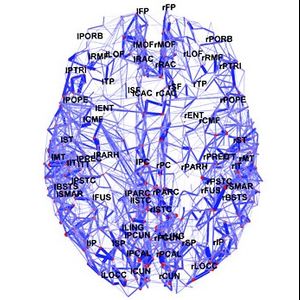IUSM ConnPipe
Executive Summary
ConnPipe is a collaboration between the Center for Neuroimaging (CfN), the RT Scalable Compute Archive (SCA), and IUSM researchers. The scope of the project has consisted of refactoring, optimizing, and deploying on IU cyberinfrastructure a comprehensive connectome pipeline that uses state-of-the-art tools developed in the field. The connectome pipeline, written in bash and python, executes pre-processing of Magnetic Resonance Imaging (MRI) data, and produces functional and structural connectomes. The current version of the pipeline has been widely tested, and is currently supporting research at the IU School of Medicine and other IU affiliated researchers. The project is funded by CfN.
Neuroimaging Initiatives and Advantages of ConnPipe
Neuroimaging is a rapidly evolving field with a wide variety of available methods. Oftentimes, due to uncertainties regarding the biological or physiological significance of different imaging modalities and preprocessing methods, a lack of consensus within the scientific community can limit the societal implications of analyses. As neuroimaging continues to expand and evolve, scientists at the forefront of the field are continually developing novel ideas toward methodological approaches. Researchers at IU are no exception to this initiative. Collaborators between Research Technologies (RT) within University Information Technology Services (UITS) and the Center for Neuroimaging (CfN) within the IU School of Medicine (IUSM) have sought to develop their own Magnetic Resonance Imaging (MRI) processing pipeline, ConnPipe, to tackle the ongoing research toward clinical applications of neuroimaging. ConnPipe is a constantly evolving pipeline that aims to take advantage of state-of-the-art processing methods while providing opportunities for in-house customizability. As a multimodal pipeline, ConnPipe allows for processing GE and SIEMENS MRI scanners, and a variety of imaging protocols. The pipeline offers various options for T1 brain segmentation, a variety of cortical and subcortical parcellations (including multi-scale parcellations); the functional MRI pipeline can handle Gradient echo or Spin echo field maps, and can take advantage of pre-calculated distortion field maps to be applied for subsequent EPI scans, saving significant computation time. ConnPiple is designed as a modular pipeline, allowing the user to select which modules to execute. This results in an easy to debug and flexible pipeline. With various processing options available, the user can easily select which modules to run by turning flags on and off, and by adjusting each module’s parameters.
For functional connectomes, ConnPiple offers various signal and nuisance regression options that can be turned on and off, including aCompCor, bandpass filtering or DCT detrending/high-pass filtering, ICA-AROMA, Rigid Motion regression, global signal regression, scrubbing, among others.
For DWI processing, the pipeline can process single and two phase encoding (as generally implemented in multi-site protocols, e.g., A-P and P-A). The pipeline performs various Quality Control checks that the user can inspect while processing data. This allows the user to verify whether the processing steps are successful, thus preventing unnecessary processing of data when QC has failed at early stages of the pipeline.
Working together with RT to develop ConnPipe, the CfN and affiliated IU neuroimaging laboratories are in a unique position to explore the full scope of available methods under a singular processing framework. Utilizing ConnPipe bodes well for everyone. On one hand, applying the same processing strategies across laboratories helps to ensure consistency and verifiability of results. On the other hand, as methods inevitably evolve, organizing novel applications under a common framework helps to ensure that all laboratories are equipped with a full repertoire of tools for their research.
Currently, the pipeline is already being utilized at the CfN to explore changes in brain networks for patients undergoing hormone therapy (HT) for breast cancer. In addition, we have collaborated with the Alcohol Research Center (human component) to process over 40 subjects from an imaging data set acquired at the IUSM Center for Neuroimaging.
